Municipal strategies which exacerbate the housing affordability problem today look less like indifference and more like active hostility, as pointless as it is cruel.
By Shawn Selway
Published March 05, 2020

Future foggy. Source: Yakir, Pixabay.
According to on-the-ground estimates made by King Street Tenants United, the managers of the Hamilton light rail transit (LRT) land procurement process have thus far removed from the rail corridor the residents of 178 dwelling units and shuttered about 57 commercial fronts.
This does not quite square with what Kris Jacobsen, the director of the LRT project office, told Council's General Issues Committee on Dec 4. Jacobsen reported that Metrolinx had acquired 15 residential properties containing 55 residential units, only 40 of which were occupied.
The discrepancy suggests that Tenants United may be counting vacant units not actually held by Metrolinx. (For details of the KSTU methodology, see the relevant article at their website.)
In addition to Metrolinx activity, many other properties are changing hands in and around King East, and the displacement of renters by private speculators who are buying in or near the corridor and renovicting sitting tenants is much harder to quantify. What is certain is that there is a great deal of turmoil.
Who are the people who are being pushed out?
Back in March 2009, IBI Group consultants working with HDR Decision Economics delivered an "Economic Potential Study" of the Hamilton Rapid Transit Initiative, as it was then called. The study concentrated primarily on the B-line corridor and was meant to be "indicative" rather than whatever the converse is called in consultant-speak. The study included a "social needs assessment" of those who were living in the corridor, and the results of that assessment were summarized as follows.
The proposed rapid transit corridor covers areas of relatively high social need. Persons with social needs may include those who are unemployed, lone parent families, low educational attainment, low income or high rates of government assistance. The B-Line corridor stands out within Hamilton as well as regionally, provincially, and nationally in every category except for its proportion of seniors. For example, 35% of people living in the corridor are classified as low income compared to the national average of 15%. The implementation of rapid transit should be positive in that it provides these individuals with greater access to employment opportunities and health and wellness activities, but cautioned (sic) must be exercised so as not to displace these individuals from the corridor. (IBI/HDR p.3)
| Indicator | Corridor | Hamilton | GTHA | Ontario | Canada |
|---|---|---|---|---|---|
| Government Transfers as a proportion of total income | 20.60% | 12.90% | 9.30% | 9.80% | 11.10% |
| Population over 65 | 14.80% | 14.20% | 12.20% | 13.60% | 13.70% |
| Lone parents | 23.60% | 14.70% | 14.20% | 15.80% | 15.90% |
| No high school certificate or diploma | 38.50% | 28.70% | 24.10% | 22.20% | 25.50% |
| Low income | 35.60% | 16.20% | 12.40% | 14.70% | 15.30% |
| Unemployment rate | 10.40% | 5.80% | 5.20% | 6.40% | 6.60% |
Since, obviously, the low-income earners cannot benefit from transit if they are no longer in the neighbourhood, IBI's cautionary note implies the implementation of a housing program in advance of the transit build, but during the ensuing ten years nothing of the sort has been undertaken.
For reasons too numerous to discuss here, the production of affordable housing, rental or otherwise for working and dependent individuals of lower income has never been accepted as a legitimate object of public policy, and their position has steadily worsened.
It has become especially difficult in the portion of East Central Hamilton bounded roughly by Ferguson, King, Barton and Kenilworth - that is, the east end of the LRT corridor, as attested by numerous reports. Also being increasingly impoverished are renters in the Centennial neighbourhoods of East Hamilton, where Real Estate Investment Trusts own the rental towers.
I want to discuss here the benefits to be gained from the initiation of a non-market housing alternative to the state-sponsored gentrification policies which are disrupting the lives of an ever larger number of Hamiltonians. The cancellation of the LRT may give us a chance to start limiting the harm done by this hellish machinery, to opt out of the pervasive condo-ism which is exacerbating many of our problems, and to develop a less imitative and more innovative strategy for Hamilton.
Let's begin with the city's own statement of the problem.
In April 2018, staff produced a report titled "Defining Affordable Housing and Hamilton's Rental Housing Market" for the edification of the Healthy and Safe Communities Committee. In addition to supplying careful definitions of affordability as defined by income comparisons and alternately by price comparisons, the authors discussed local rental market conditions.
In 2017, the average market rent (AMR) for all units in Hamilton was $943 per/month. One bedroom apartments rented for an average of $850/mo., while units with three + bedrooms had an AMR of $1,159/mo... rents and rent increases vary widely across the city as well. CMHC data shows rents are highest in Ancaster, Flamborough and Glanbrook while the most affordable rental housing is located in Central East Hamilton...
...Compared to neighbouring municipalities, rents in Hamilton remain relatively affordable; however, this affordability gap is closing. Rents in Hamilton are increasing faster than any other major urban centre in southern Ontario. Rents in the GTA remain the highest in the province; however, the places with the most rapidly increasing rents tend to be centres on the periphery of the GTA. Along with Hamilton, rents in Guelph, Kitchener, Waterloo, Burlington and Brantford are rising most quickly.
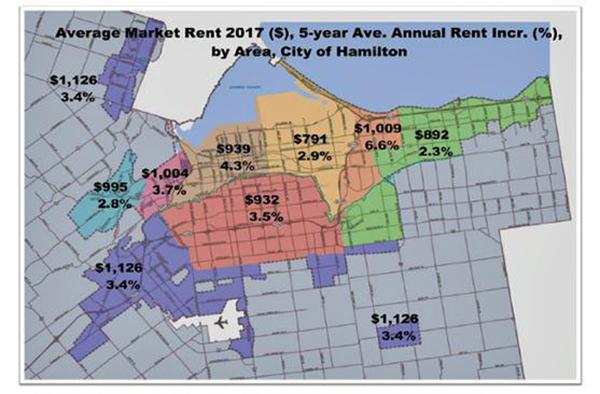
Source: City of Hamilton, Defining Affordable Housing and Hamilton's Rental Housing Market (HSC18003), April, 2018
Last summer, while members of King Street Tenants United were organizing meetings of LRT - threatened tenants, the organization received this message from a local landlord:
Subject: recent t. meetings at Bernie Morelli Centre
Message: Hello there. Your recent notices of meetings have caused a lot of unnecessary anxiety bordering on panic with a lot of tenants. Perhaps a more focused contact system could be investigated. I am a small landlord who sympathizes with tenant concerns, however please consider that tenants should never think they will stay in a building for life. This seems to be a bit of a Hamilton issue. Tenants need more support in terms of living together, sharing apartments or perhaps (and this is stressful) finding alternative accommodations in other Ontario cities. That is just part of the stress of the LRT changes. All the best.
This opinion, that a proportion of Hamiltonians should just move on now that others wish to come here, seems to be the view of some at City Hall as well.
It is not openly expressed but can be inferred from the train of decisions and omissions. This might have made wicked sense at one time. Ten years ago it was wrong for Toronto to let market pressures force emigration on some of its residents and to export its problems to other cities; it was wrong, but it was workable.
No more. There is nowhere else for renters to go to better their condition. Increased pressure on wages and rents locally can only deepen poverty. Municipal strategies which exacerbate the housing affordability problem today look less like indifference and more like active hostility, as pointless as it is cruel.
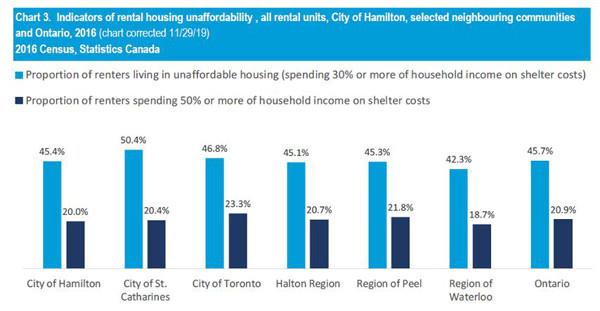
Source: Social Planning and Research Council of Hamilton, Hamilton's Rental Landscape 2019.
Let them move on? There is no place else to go.
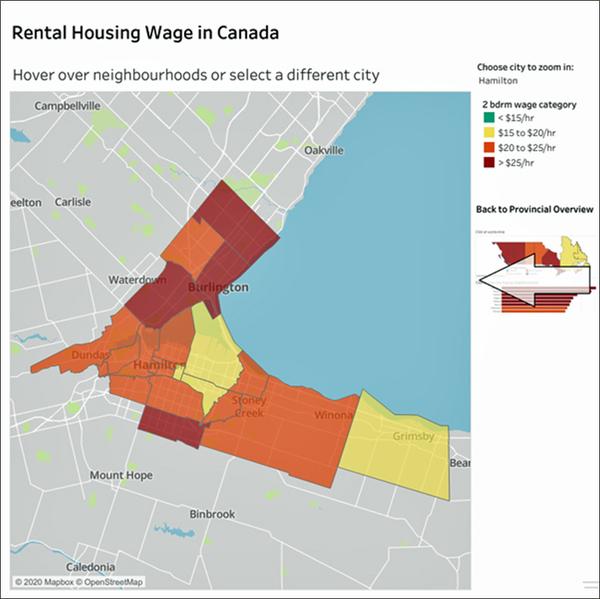
The rental wage. This map shows the wage required to rent a two bedroom apartment in the various neighbourhoods at a housing occupancy cost of 30% of gross income. (Source: https://policyalternatives.ca/rentalwages)
The Canadian Centre for Policy Alternatives last year published a series of interactive maps on which the rental wage can be viewed neighbourhood by neighbourhood. Taking a housing occupancy cost of 30% of gross income as the measure of affordability, a renter in East Central Hamilton in 2019 would have to have been making $18.57 an hour in order to pay for a 2 bedroom place.
At the fourteen dollar minimum wage, they would have had to work 53 hours a week. This area, north of King, is the cheapest part of the city. South of King Street, the "rental wage" jumps to $19.34, and it is higher everywhere else. The numbers for the city as a whole are $23 and 65 hours.
Here are the figures for a few Ontario cities, taken from the CCPA maps:
| Occupancy cost = 30% income | Hamilton | Kitchener | Guelph | St. Catharines | Brantford | Windsor |
|---|---|---|---|---|---|---|
| Rental wage | 23 | 22 | 22 | 20 | 19 | 18 |
| Hours at $14 | 65 | 64 | 64 | 57 | 55 | 50 |
A little exploration within these maps brings one to the conclusion that there are very few neighbourhoods within any of these cities to which someone could re-locate from East Central Hamilton to a comparable or cheaper apartment. This is so even after discounting moving costs, the fact that vacancy rates are lower where rents are lower, and the realities of vacancy decontrol in Ontario. Even if you move around within your own neighbourhood, you will pay much more than you are paying now.
And there are other considerations: the loss of friendships and other social supports including medical services. The insecurity and anxiety inflicted on children who have to switch schools. If a grandparent babysits sometimes, or a group of friends spell each other off with the children... All these things make it difficult and costly in time and money to uproot yourself and go elsewhere.
It is important to note, however, that at least in the case of those directly displaced by LRT, individuals are not simply being shoved aside by the LRT programmers and left to fend for themselves in a brutal housing market. No, no. They are in receipt of a lot of hand holding and even some hard cash, as Councillor Farr attempted to make "crystal clear" during the questions period that followed LRT Director Jacobsen's December 4 progress report.
The councillor was keen to get on the record an account of the good work being done for the displaced, and solicited the following testimony from Jacobsen and LRT "community engagement" head David Derbyshire. It has been transcribed from the video record of the meeting. (The video can be viewed here. Farr's contributions start around 8:00.)
Farr: ... you know, you've presented here I think the top story of the day. 15 residential properties to date. 55 residential units. 40 occupied, 15 unoccupied. 66 people requiring support. 43 people accommodated to date... and this stood out for me, that each and every one of those individuals, and being relocated and some have probably lived along the corridor for a long, long time, is hard enough. But each and every one is living in conditions better than they were before we arrived. That is, I've known personally that is important to you, to you, to your team, to Metrolinx. But to be able to state that here publicly to me is the top story of the day. Through you chair, how were you able to accomplish that?
Jacobsen: If there's one thing we're proud of so far, it's our ability to accommodate those people whose homes we're affecting. You know, we have a great tenant support structure, a great tenant support team. David Derbyshire is here. He's in the back. David leads not just our community engagement process through the Community Connectors but is also our point person when it comes to tenant supports. So, you know, David and his team work one-on-one with every individual that we affect... And it's not always easy. It takes some time. But, you know, we feel it's incredibly important that we ensure that the people that we relocate as part of this project are put into a better situation than where they're coming from... We hope that we can achieve that. So far, we have and I'm happy to report that. But really, it goes back to the team that we have and the passion that they have for just helping people.
Farr: ... David do you see any roadblocks or issues with maintaining this impeccable record going down the road, knowing that there will be more displacements happening? ...
Derbyshire: Wow. What a question. Yes there are roadblocks. Yes there are barriers. The reality is our city's rental market is skyrocketing. We are having to assist folks in finding accommodations that they can be comfortable with-in, that they would be proud to move into. So the reality is, what they're paying now doesn't equal what they'll be paying in the future. Our partners at Metrolinx have enabled us to do some very creative things to help our tenants. And they are our tenants. We take that responsibility. We meet with them individually and really get a sense of what their needs are, what their limits are, and help them find something that is going to be sustainable for them long term. This isn't just a quick fix, we'll do something that will cover them for a couple of months and then good luck in the future. We make sure that what they're moving into is going to be sustainable for them long-term."
Farr: ... Real estate and rents - this has been an issue ... this has been a problem for three, four years now where the rents have gone up in conjunction with the assessments. So obviously you had to deal with that issue with these 43 people accommodated to date and 66 people requiring support. What you said, Metrolinx did some creative things. What creative things did they do to accommodate the needs, the limits, and the sustainability over long periods of time that you included in your answer? ...
Derbyshire: One of the first things that we did is we individualized this to every tenant and their previous situation. We didn't apply a blanket strategy to address everyone on the corridor. What we did is we met with the individuals, helped them recognize what their current situation was, what their-where they stood, and then helped them find the best possible solutions for their situation.
Jacobsen: So through the chair, if I can add to that as well, some of the additional supports, and David might be able to speak to this in greater detail than I can but, you know, some rent supplementation, moving expenses, assisting them with utility hookups, and, you know, working them through difficult application processes. You know, there's a number of supports that we do provide. I don't know David if there's anything additional you'd like to add.
Derbyshire: Even as much as helping them with tenant insurance. The real estate market out there for rental accommodation has changed dramatically in the last five years. A lot of prospective tenants face the reality of having to go through elaborate application processes, through property managers, never get a chance to meet with the actual landlord themselves. So we assist them in navigating these processes that have been put in place. We make sure that at the end of the day they are comfortable with whatever, whatever they are able to find. And again, we assist them in finding these locations... We help them find alternatives, examine those alternatives, and decide which one will best meet their needs. Sometimes they have a choice. Often times they don't. You know, they are only acceptable in certain locations.
Farr: Right. Excellent. So, to be clear though, because you did mention that we're in a great peak in terms of higher rents that we haven't seen ever. And then ... one of the ... creative things that David Derbyshire mentions is "rent supps" so I want to be crystal clear here today. Through you chair to Kris, we're not taking Mr. and Mrs. Smith, a couple who've been living near the corner of King and Sherman for 20 years paying $685 a month in rent, and putting them in a unit where they're now paying $1,265. And if it is a $1,265 unit, that rent supp is covering the difference? So they're paying what they've traditionally paid?
Derbyshire: You must have spoken to Mr. and Mrs. Smith. Yes, we attempt to do that... What we also do though, we make sure that we don't put people in over their head. So if they do agree to move into a $1,200 unit after previously living in a $600 unit, we make crystal clear what their plan is beyond the length of our subsidy. Metrolinx can't afford to subsidize families forever. There's a limit. There's a timeline on what that subsidy will be. And again, it's individualized for the family... So we make sure that when the subsidy is over the family, the individual has a strategy for continuing to be able to pay that rent. So it might be "Well, you know, my boyfriend is going to be moving in with me in six months so when that happens, I will be able to-or we will be able to cover the additional rent ourselves." That's just one example of a strategy that they would have put in place. Or "My daughter is moving in with me and she will assist with the rent moving forward."
Farr: That's good. Thank you.
It remains only to add the councillor's enthusiastic tribute to presumed LRT-induced development.
For proponents and supporters, right from the get go. Myself, others around this table. I think the excitement is really beginning to build... The private investment that's going on, I mean, we're safely well over a billion and a half in LRT supportive development, in the core mostly but I think in other spots. And I've just had two meetings last week with two mid-size, straight to site plan developments by two LRT supportive developers. One is done sales and ready for demolition at Kiwi in International Village, as you know. I always say I think that is going to be the most coveted piece of real estate once this is all through... And one right beside it at Jarvis Street, there's a great deal of interest in the old TiCat office there. So I see this all the time...
This should make it all as "crystal clear" as the councillor could wish.
However, to avoid any possible misunderstanding whatever, here is the succinct and precise definition of the LRT project that Councillor John-Paul Danko recently provided to the Spec ("Province says task force to consider highways for Hamilton", Hamilton Spectator, Jan 2, 2020).
At its core, LRT is an economic development investment designed to reduce residential property taxes city-wide through new high-density urban and commercial development along the LRT corridor.
We might add the corollary, that the interests of the residents of East Central Hamilton are to be sacrificed to those of home owners in the rest of the city. Those who have the least must have still less in order to benefit the rest.
The IBI report (pg. 52) put it like this:
Unless the City chooses to increase property taxes to reflect new service provision, it will not realize additional tax revenue from changes in property values due to the LRT system. A redistribution of the tax burden may occur, with owners of lands near the new LRT line paying higher taxes due to an increase in property assessment. This in turn would result in a decrease in property taxes charged for other land owners.
However,
Changes to the City's tax base resulting from increased assessments following redevelopment and growth could generate new property tax revenue ... the 455 parcels of vacant land within the study area currently have very low assessment values and as such generate little tax income for the City.
Here is the potential residential capacity of the corridor.
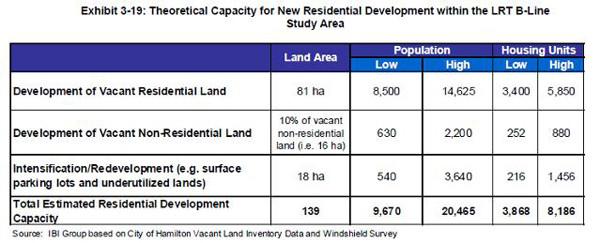
Theoretical Capacity for New Residential Development Within the LRT B-Line Corridor (Source: IBI Group based on City of Hamilton Vacant Land Inventory Data and Windshield Survey)
In addition, there are another 156 hectares of non-residential land that could be brought into use. Certainly in the ten years since these estimates were made, things have changed, but the numbers suffice to give a notion of the scale of redevelopment that is envisaged in the corridor.
Of course, this is just what LRT supporters have been saying all along, with little effect on their opponents, who generally fall into three camps: those who have been put out of their homes by the project, or fear, quite rightly, that they are next to go; those who insist on evaluating the thing primarily as a transportation project, no matter how often they are corrected; and those who believe that LRT operating costs will raise their taxes, when council has demonstrated that they are far more likely to drain funds from the rest of the HSR system to service LRT than increase taxes to cover both should the need arise.
Finally, there is a fourth, much smaller group of people whose public figures are Councillors Clark, Collins and Whitehead, and Liberal backroom boy turned mayoral candidate Vito Sgro, who are either opportunists working a wedge issue or playing a deeper game, it's not clear which.
Although the provincial Growth Plan would likely be well served by the intensification proposed for the LRT corridor, owners of land outside or near the current urban boundary might prefer that the transportation system be rejigged to point in that direction. However, Waterdown and Elfrida are almost fully built out, as long as the Growth Plan boundaries hold, and it is impossible to imagine the eventual residents of the greenbelt lands (Elfrida, Twenty Road East and Twenty Road West, 1,760 hectares in total) getting out of their cars and onto a bus.
It will be interesting to see how Clark, Collins and Whitehead respond to the highway proposals which the Conservatives are wanting to include in the LRT substitute that is being formulated. The Ford Government's No-LRT plan is likely to be a whole lot of highway and not much public transit, which will ultimately compound both our infrastructure deficit and our difficulties in meeting our climate change obligations.
The LRT cancellation was abrupt, but we have been here before. Historian Margaret Rockwell has written in detail about earlier episodes of planning policies imposed to realize large scale reconfigurations of the city that did not go as expected. In the second part of this piece, we'll see if there is anything to be learned from the earlier episode, and make the argument for a non-market solution to the housing problems.
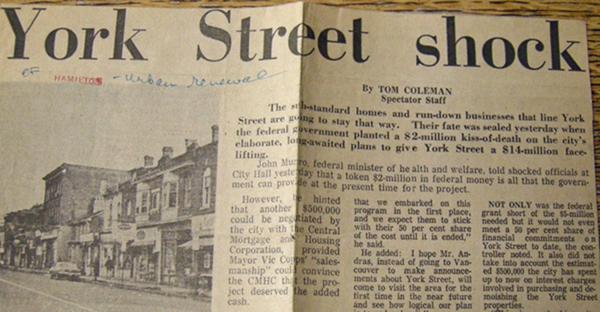
Source: Hamilton Spectator, n.d., 1970?, Hamilton Public Library Special Collections
You must be logged in to comment.
There are no upcoming events right now.
Why not post one?